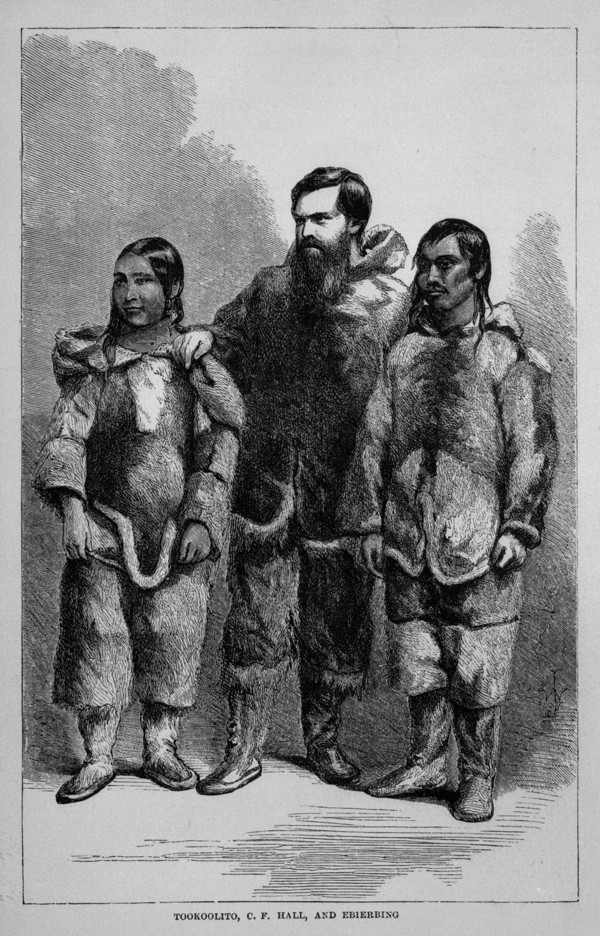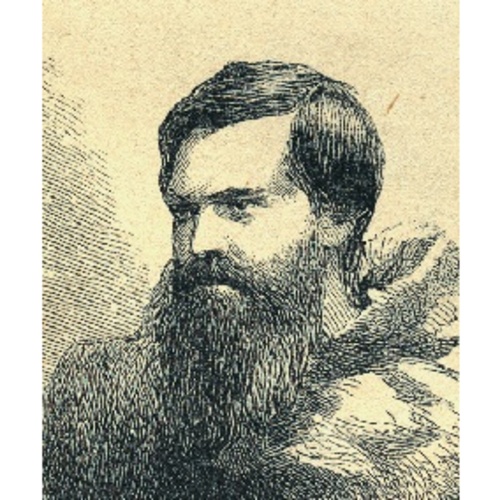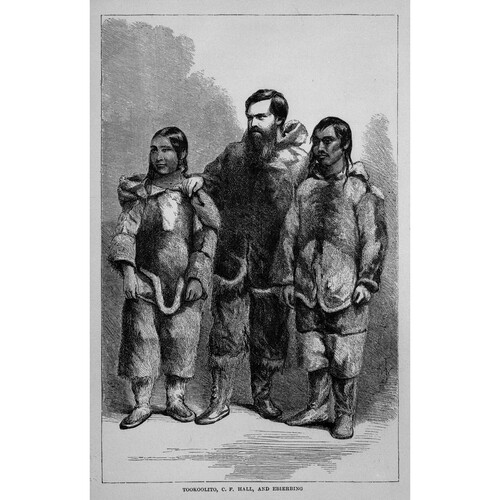HALL, CHARLES FRANCIS, Arctic explorer; b. 1821; d. 8 Nov. 1871.
Charles Francis Hall was born in the state of Vermont in 1821, but while he was still a child his family moved to Rochester, New Hampshire, where he spent his boyhood and received what little formal schooling he was given. In the 1840s he married and drifted westward, arriving in Cincinnati, Ohio, in 1849. There he established a small seal-engraving business and, in the late 1850s, two small newspapers, the Cincinnati Occasional and the Daily Press.
During Hall’s years in Cincinnati, he developed a passionate interest in the Arctic, reading widely in its geography and history. Always driven by boundless energy and an inquiring mind, he decided in 1859, at the age of 39, that he was destined to find survivors of Sir John Franklin*’s expedition, which had disappeared almost 15 years before. The discovery in 1859 of bodies and relics of the Franklin expedition on King William Island by Francis Leopold M’Clintock* did not deter Hall or change his belief that there might be survivors living with the Eskimos.
Although his businesses had been moderately successful, Hall had little money. Furthermore, he knew nothing about navigation. Early in 1860 he went to the east coast and there met the founder of the American Geographical and Statistical Society and patron of United States Arctic exploration, Henry Grinnell. Grinnell gave him introductions to whaling firms in New London, Conn., one of which offered Hall free passage to Baffin Island. Hall sailed north for the first time on 29 May 1860 on the bark George Henry, Sidney O. Budington, captain.
Hall’s plan was to put ashore at “Frobisher Strait,” hire Eskimos, navigate through the so-called strait to Foxe Basin, and from there make his way to King William Island. His expedition boat was destroyed, he discovered that the strait was actually a bay, and he did not even approach King William Island, but his first expedition was not a complete failure. He not only proved that the strait was a bay but also, by finding relics of Sir Martin Frobisher*’s attempts to mine gold on his third expedition, that it was indeed the site of the Elizabethan’s 16th-century explorations. Hall also hardened himself to living in the Arctic environment, helped by a remarkable English-speaking Eskimo couple, Ebierbing and Tookolito, known to whalers as “Joe” and “Hannah.” They had been taken to England by a British whaler in the early 1850s, and according to legend enjoyed tea with Queen Victoria.
After two years in Frobisher Bay, Hall returned to the United States, bringing Joe and Hannah with him. He virtually ignored the war between the states, which was at its height, to devote all his energy to gathering money for his next expedition. He lectured, using the Eskimos in their native costumes as an attraction, and worked on a book about his first expedition, Arctic researches and life among the Esquimaux . . . (New York, 1865, published in London in 1864 as Life with the Esquimaux).
Hall still insisted that even after almost 20 years there might be survivors of the Franklin expedition living in the area of King William Island, and he persuaded Grinnell and the American Geographical and Statistical Society to help him on his next venture. In July 1864, still accompanied by the loyal Joe and Hannah, he sailed again with Captain Budington in the whaler Monticello to northern Hudson Bay. In the four years that followed, he led a life of hardship and frustration in the area of Roes Welcome Sound. Except for occasional visits to whaling ships, he stayed with Eskimos, trying unsuccessfully to persuade them to accompany him to King William Island. For a brief time, despairing of their help, he hired some whalemen, but this experiment ended violently when he shot and killed one for threatening mutiny. Finally in the spring of 1869 he made his way to King William Island, helped by Joe, Hannah, and several other Eskimos. In spite of rumours that there were white men living in the area, all he found of the Franklin party was more relics and skeletal remains.
During this expedition, he determined to try to reach the North Pole on his next venture. Soon after his return to New Bedford, Mass., in September 1869 he gained the attention of President Ulysses S. Grant and of some powerful men in Congress. Fifty thousand dollars were appropriated, and Hall was put in command of what became known as the Polaris expedition (named after his ship, the 387-ton Polaris).
At last Hall had a large-scale, well-financed expedition, but the Polaris expedition proved to be ill fated. Sailing early in July 1871, the Polaris, captained by Budington, easily set a record farthest north of about 82º11´ by September, cruising up the narrows between Ellesmere Island and Greenland. Turned back by ice at the edge of the Lincoln Sea, Hall had Budington put the ship into a shallow harbour on the northwest shore of Greenland, which he called “Thank God Harbour.” There they prepared to winter. In October Hall made a two-week sledge journey to the north. When he returned to the ship, he became violently ill after drinking a cup of coffee. For two weeks he was sick, apparently paralysed on one side and sometimes demented. In his dementia he accused many of the officers of murdering him. He died on 8 Nov. 1871 and was buried ashore.
After Hall’s death, the morale of the expedition deteriorated and little was accomplished. In the fall of 1872, when Budington tried to sail the badly damaged Polaris southward, a party of 19 men, women, and children – the Eskimos had their families with them – were separated from the ship on an ice floe during a storm in Smith Sound. After six months during which they drifted some 1,300 miles on the floe, the party (which included George E. Tyson) was rescued by a sealer off Labrador. In the meantime, Budington had run the Polaris aground near Etah, Greenland, where he and the rest of the expedition spent the winter. They were picked up by Captain William Allen of the Scottish whaler Ravenscraig in the spring.
A navy board of inquiry cleared Budington of any serious charges and reached the conclusion that Hall had died of apoplexy. The transcript of its investigation, however, shows that the expedition had been seriously weakened by hostilities among the officers. Budington had been drinking heavily and had quarrelled with Hall. Dr Emil Bessels, the expedition’s surgeon and naturalist who had treated Hall in his final illness, also had quarrelled with him.
In August 1968 Hall’s well-preserved remains were exhumed by a party of investigators, and a graveside autopsy was performed. Neutron activation tests run by Toronto’s Centre of Forensic Sciences on his hair and fingernails proved that during the last two weeks of his life he had received large amounts of arsenic (76.7 ppm at the base of his fingernail). That the cause of his death was arsenic poisoning cannot be conclusively proved although the dosage he had received was very large. Nor can it be proved that he was murdered: he owned a medical kit of his own and, distrusting Dr Bessels, he may have overdosed himself with an arsenical patent medicine. In spite of the new evidence, Hall’s death must remain a mystery forever.
The irony of the Polaris expedition is that, although Hall had always wished to command a large-scale expedition, he was far more successful as a lone-wolf explorer than as an expedition leader. His greatest contribution to Arctic exploration was perhaps in proving that a white man living as the Eskimos lived could survive for long periods of time in the Arctic free from ships or other sources of civilized supplies. In his adaptability to the Arctic environment, he was the predecessor of Vilhjalmur Stefansson*. And like Stefansson he was a propagandist for the Arctic, enthusiastically praising its beauty and its potential value for the civilized world. In one of his typical lectures, delivered just before the departure of the Polaris expedition, he said: “Many who have written to me, or who have appeared to me personally, think that I am of an adventurous spirit and of bold heart to attempt to go to the North Pole. Not so. It does not require that heart which they suppose I have got. The Arctic Region is my home. I love it dearly; its storms, its winds, its glaciers, its icebergs; and when I am there among them, it seems as if I were in an earthly heaven or a heavenly earth.”
Smithsonian Institution (Washington), Division of Naval History, Charles Francis Hall papers. C. F. Hall, Arctic researches and life among the Esquimaux: being the narrative of an expedition in search of Sir John Franklin, in the years 1860, 1861, and 1862 (New York, 1865); [C. F. Hall], Life with the Esquimaux; the narrative of Captain C.F.H. . . . from the 29th May, 1860, to the 13th Sept., 1862; with . . . the discovery of actual relics of Martin Frobisher . . . and deductions in favour of yet discovering some of the survivors of Sir J. Franklin’s expedition (2v., London, 1864). Narrative of the second Arctic expedition made by Charles F. Hall: his voyage to Repulse Bay, sledge journeys to the Straits of Fury and Hecla and to King William’s Land, and residence among the Eskimos during the years 1864–’69, ed. J. E. Nourse (Washington, 1879). Narrative of the north polar expedition: U.S. Ship Polaris, Captain C. F. Hall, commanding, ed. under the direction of G. M. Robertson by C. H. Davis (Washington, 1876). “Report of the reception, by the American Geographical Society, of Captain Hall and his officers, previous to their departure for the Arctic regions, held June 26th, 1871,” American Geographical Society of New York, Journal, III (1870–71), 406. [G. E. Tyson], Arctic experiences: containing Capt. George E. Tyson’s wonderful drift on the ice-floe, a history of the Polaris expedition, the cruise of the Tigress, and rescue of Polaris survivors, ed. E. V. Blake (New York, 1874). DAB.
Cite This Article
Ernest S. Dodge and C. C. Loomis, “HALL, CHARLES FRANCIS,” in Dictionary of Canadian Biography, vol. 10, University of Toronto/Université Laval, 2003–, accessed April 27, 2025, https://www.biographi.ca/en/bio/hall_charles_francis_10E.html.
The citation above shows the format for footnotes and endnotes according to the Chicago manual of style (16th edition). Information to be used in other citation formats:
| Permalink: | https://www.biographi.ca/en/bio/hall_charles_francis_10E.html |
| Author of Article: | Ernest S. Dodge and C. C. Loomis |
| Title of Article: | HALL, CHARLES FRANCIS |
| Publication Name: | Dictionary of Canadian Biography, vol. 10 |
| Publisher: | University of Toronto/Université Laval |
| Year of revision: | 1972 |
| Access Date: | April 27, 2025 |





